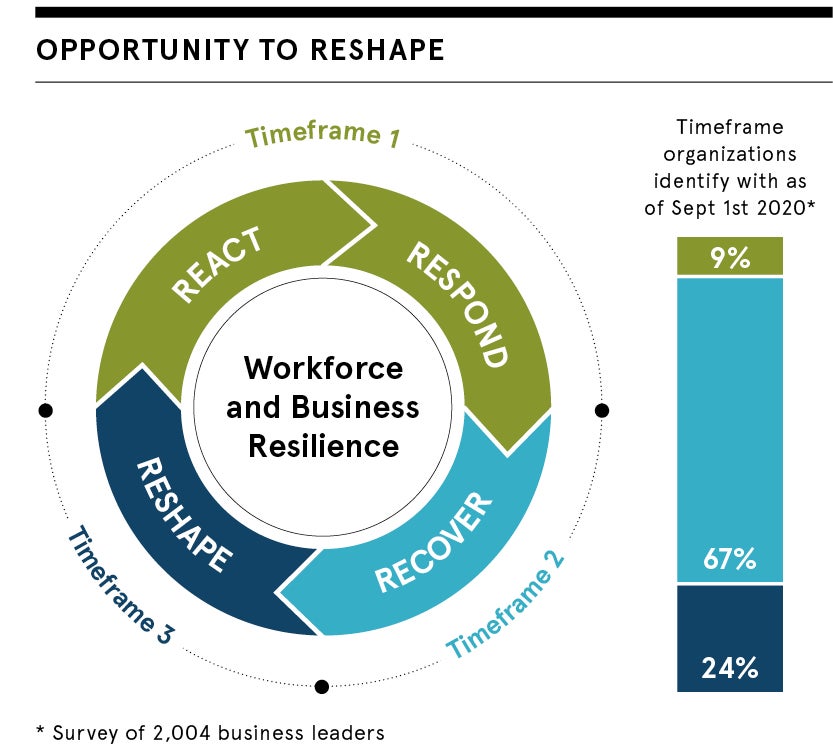
Before the outbreak of the coronavirus pandemic, there was no doubt technology was disrupting the workforce and companies’ business models, yet most organisations did not feel equipped to activate a digitally ready workforce. But the health crisis and economic consequences have now forced businesses to adapt more quickly to a changing world.
Since March, surveys by Aon have gathered insights into how organisations are responding to the pandemic and the workforce changes they are making. Already in May, 84 per cent of human resources leaders reported they were exploring new working models, with 80 per cent seeing a mix of office and virtual working as the new model. However, four out of five survey respondents also reported they didn’t understand the capabilities of their workforce.
The future of work can only be a nebulous concept when you lack the data on which to base decisions
“In the initial phase of the pandemic, companies had to change quickly how and where people work, and leaders had to make decisions based on incomplete datasets,” says John McLaughlin, chief commercial officer, Human Capital Solutions, Europe, Middle East and Africa, at Aon, which provides leaders with the data, analytics and advice to make better workforce decisions. “Agile decision-making is difficult to achieve in a virtual workplace, often requiring large-scale infrastructure changes and different processes and structures.”
Looking at crisis response and recovery with the view their workforce model would eventually return to what it was, many companies made changes that were necessary, but no more. Though most now recognise home working as a long-term trend, only 25 per cent have reached a stage of actively reshaping their future, according to Aon’s latest research. They know they have to act, but are too often unsure of how to do so.
In an uncertain landscape, it is perhaps understandable organisations struggle to predict their future workforce needs. Indeed, 75 per cent of respondents to Aon’s August COVID-19 Pulse Survey said digital skills are key to an agile workforce, yet 61 per cent of HR leaders reported that their organisations do not know how to spot digital potential. For many, the future of work can only be a nebulous concept when you lack the data on which to base decisions.
Aon’s Accelerate Model helps companies to think through change across not only HR but importantly the organisation as a whole. It helps to quantify the opportunity of workforce change. The framework powers better workforce decision-making by enabling organisations to answer questions in a better, more detailed way and one which is designed for their unique organisational challenges.

By analysing data and workforce capabilities together, companies can solve workforce issues in a more meaningful way. For example, they should manage diversity and remote working together, as 86 per cent of survey respondents say a diverse workforce is key to building an agile workforce.
“That’s the power of ‘and’,” says Michael Burke, chief executive of Human Capital Solutions at Aon. “The Accelerate Model analyses data through over 40 criteria before giving a reliable, validated and considered set of priorities to tackle. The data is curated via an intelligent and robust framework, and the results are objective, contextualised and actionable. This is how we enable an evolving and compound impact on change.”
Aware that 30 per cent of its workforce will see their existing skillsets become obsolete over the next three to five years, manufacturing giant Siemens turned to Aon to provide a platform that matches employees to appropriate reskilling and upskilling opportunities.
Aon’s platform enables workforce agility by fostering future skills, reduces costs through redeployment rather than hiring expensive external resources, and controls people risk in the form of fostering loyalty and lowering staff turnover.
“Siemens can now understand who has the potential to reskill and upskill, and think through their learning and development interventions in a better way,” says McLaughlin. “They can also better understand where their return on investment and dollar spend in this area are high, quantify the impact of intervention and present a clear business case for future-proofing their workforce. They’re breaking down the complexity of the future of work and making it real by creating a data-driven understanding of their workforce.”
For more information please visit humancapital.aon.com/accelerate
Promoted by AON

Before the outbreak of the coronavirus pandemic, there was no doubt technology was disrupting the workforce and companies’ business models, yet most organisations did not feel equipped to activate a digitally ready workforce. But the health crisis and economic consequences have now forced businesses to adapt more quickly to a changing world.
Since March, surveys by Aon have gathered insights into how organisations are responding to the pandemic and the workforce changes they are making. Already in May, 84 per cent of human resources leaders reported they were exploring new working models, with 80 per cent seeing a mix of office and virtual working as the new model. However, four out of five survey respondents also reported they didn’t understand the capabilities of their workforce.
The future of work can only be a nebulous concept when you lack the data on which to base decisions

